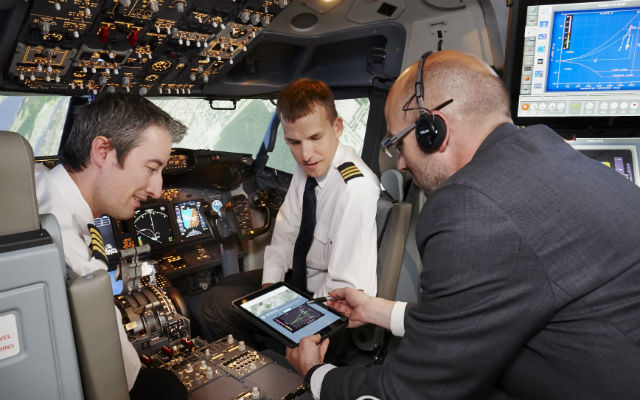Real-time data monitoring and analysis will be coming soon to full-flight simulators (FFS), and both the pilots being trained and the simulator operator will feel the benefits.
Embedded in the new CAE 7000XR (extreme reality) level D FFS – for which first delivery is scheduled by the third quarter this year – are capabilities for tracking a pilot’s performance during training scenarios, while also tracking the health of the simulator’s components.
The pilot performance monitoring incorporates CAE’s simulator operational quality assurance (SOQA) concept – introduced three years ago as a post-simulator debriefing tool.
However, instead of waiting until the end of a 4h simulator session, instructors will be able to use a tablet or smartphone as a “mobile monitor” to immediately show the crew what they did during a training manoeuvre.
The instructor can use the SOQA tool “a minute or two after something happens with objective data”, says Bruno Cacciola, director of product strategy and marketing for CAE’s civil aviation business.
“This will be more effective than waiting until after the entire lesson, where you’re already one step removed,” he says. “You can discuss it right there and then, and then move on to the next event in the training session.”
Cacciola says the SOQA tool can currently monitor parameters for about 20 pre-programmed training events, including adherence to speed envelopes during different parts of a flight, deployment of flaps and gear at the appropriate times, pitch attitude on take-off, touchdown points and other airline standard operating procedures. The application on the instructor’s tablet can show if an approach is unstable, too fast, too high or exceeding a number of other thresholds.
In an upset prevention and recovery training scenario, the application allows the instructor to monitor how the pilot manages the upset condition and recovery process, including angle of attack.
To assuage pilots and unions concerned about data from poor training performances being used against them in the future, Cacciola said the SOQA information is “only available for the instructor and crew interaction at the moment. That’s where it ends”.
“Once you leave the simulator, we’re not taking the data with us. It creates a secure environment in which the instructor can discuss things with the crew,” he says.

A tablet or smartphone will allow almost immediate analysis of training manoeuvres
CAE
The SOQA tool is part of CAE’s overhaul of the on board “instructor’s office” – focused on incorporating handheld mobile devices as sort of an instructor’s electronic flightbag. In the future, instructors may be able to develop lesson plans and scenarios offline, then upload them to the simulator.
“We foresee this giving us a platform that we can easily upgrade with more training applications,” notes Cacciola. “A lot of how the instructor will work in the future and the tools we use will gravitate toward mobile devices.”
For the simulator operator, whose primary objectives are maximising uptime and reducing lifecycle costs, CAE’s Sentinel simulator diagnostic monitoring system should provide significant predictive insight. CAE is using a multipurpose interface card (MPIC), similar to those used in smartphones, to self-monitor hundreds of simulator components and functions, such as unstable electrical currents, visual projection system lamp brightness and motion jack friction levels.
Instead of waiting for a part to fail – which can crash an aircrew’s training session and throw numerous schedules out of sync – Sentinel can flag up a possible failure based on the accumulated knowledge of each component type from multiple simulators. Prior to an anticipated failure, proactive maintenance can be scheduled at a time convenient to the operator.
The data from individual simulator MPICs is also available remotely to simulator operators via centralised cloud computing, so a technician does not need to physically check each FFS. Data from customer simulators can also be relayed back to CAE at its Montreal headquarters, where a support team continuously monitors each device’s health and aggregates historical performance trends.
The Sentinel capability can be retrofitted to CAE’s previous-generation 7000 series FFS, and would be “easy to implement”, Cacciola says, on the now out-of-production 5000 series for commercial narrowbody and business aviation simulators. Integration with older simulators may also be possible.
Source: Flight International























